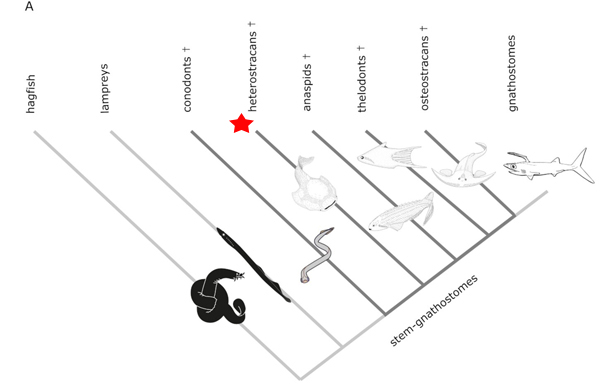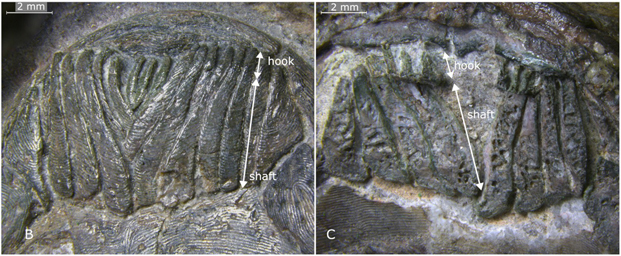The evolution of a jaw and the transition from passive feeding to predatory behaviour is regarded as one of the most significant events in the evolution of vertebrates. It has been suggested that early vertebrates were passive, suspension feeders. They removed particles of food in the water column by some form of filtration. Over time, a more predatory, active lifestyle evolved. Living jawless vertebrates today such as the Hagfish (Myxinidae family) are scavengers as well as predators. Studying these animals can help to inform palaeontologists about the potential feeding strategies of extinct jawless fish. However, the feeding strategy of these animals and jawed stem-gnathostomes (the phylogenetic intermediates of living jawless and jawed vertebrates) remains unclear.

New and Innovative Research into Extinct Jawless Fishes
A new scientific paper, published in the Journal of Vertebrate Paleontology casts doubt on the idea that some jawless vertebrates were filter feeders. Scientists from the University of Bristol used innovative research techniques to examine the dentition of extinct jawless heterostracans. The Heterostraci are an extinct subclass of the Agnatha (jawless fishes).
The research discovered that the forward-facing denticles on the oral plates of heterostracans were not adaptations for filter feeding.
Madleen Grohganz, the lead author of the paper from Bristol University’s Palaeobiology Research Group commented:
“The origin of vertebrates, our very own evolutionary lineage, is widely regarded as one of the most important events in evolutionary history. Early vertebrate evolution is a much-debated topic among biologists and palaeontologists and there are still many unresolved questions.”

The Jawless Heterostracans
Heterostracans are among the oldest of all the vertebrates. Their mode of feeding remains controversial. To determine whether they were filter feeders or predators sophisticated modern computational palaeobiological techniques were employed in this study.
Heterostracans possessed a feeding apparatus of rod-like oral plates with rows of forward-facing denticles outside of the mouth. These traits had been thought to represent combs for filter feeding.
The team employed Computational Fluid Dynamics (CFD), a technique from engineering that simulates fluid flows and their interaction with solids to test this hypothesis. Water flow modelled around these structures would indicate whether these oral plates were effective at filtering out particles of food.
All the tested models, independent of denticle orientation, showed similar flow, velocity and vorticity patterns. Based on these analyses the team rejects the hypothesis that denticle orientation is a specific adaption to suspension feeding. The denticles only occur on the lateral sides of the very tip of the oral plates. They may have played a role in preventing oversized food particles, sediment or parasites from lodging between the plates.
Madleen Grohganz stated:
“Our study is one of the first, that actively tests feeding mode hypotheses of early jawless vertebrates instead of making poorly constrained inferences. This is an important step towards better understanding the feeding mode of early jawless vertebrates, testing evolutionary scenarios and ultimately shedding more light on early vertebrate evolution.”
More Research into Stem-gnathostomes Required
The feeding strategies of stem-gnathostomes remains largely unknown. The researchers conclude that other feeding theories such as whether heterostracans were capable of biting still require testing.
The exact nature of heterostracan feeding remains an open question. Other feeding hypotheses, which propose a mechanical function related to active biting or scavenging, still need to be tested. The creation of three-dimensional skull models based on non-destructive CT scans could yield more evidence to help inform palaeontologists. Madleen Grohganz and her colleagues agree that more research is required on these basal vertebrates.
Dr Grohganz explained:
“Previous feeding mode hypotheses of early jawless vertebrates have mainly been based on poorly constrained inferences. But using computational palaeobiological methods, we were able to actually test and reject one of these feeding mode hypotheses.”
Everything Dinosaur acknowledges the assistance of a media release from the University of Bristol in the compilation of this article.
The scientific paper: “Testing hypotheses of pteraspid heterostracan feeding using computational fluid dynamics” by Madleen Grohganz et al published in the Journal of Vertebrate Paleontology.
Visit the Everything Dinosaur website: Everything Dinosaur.






Leave A Comment